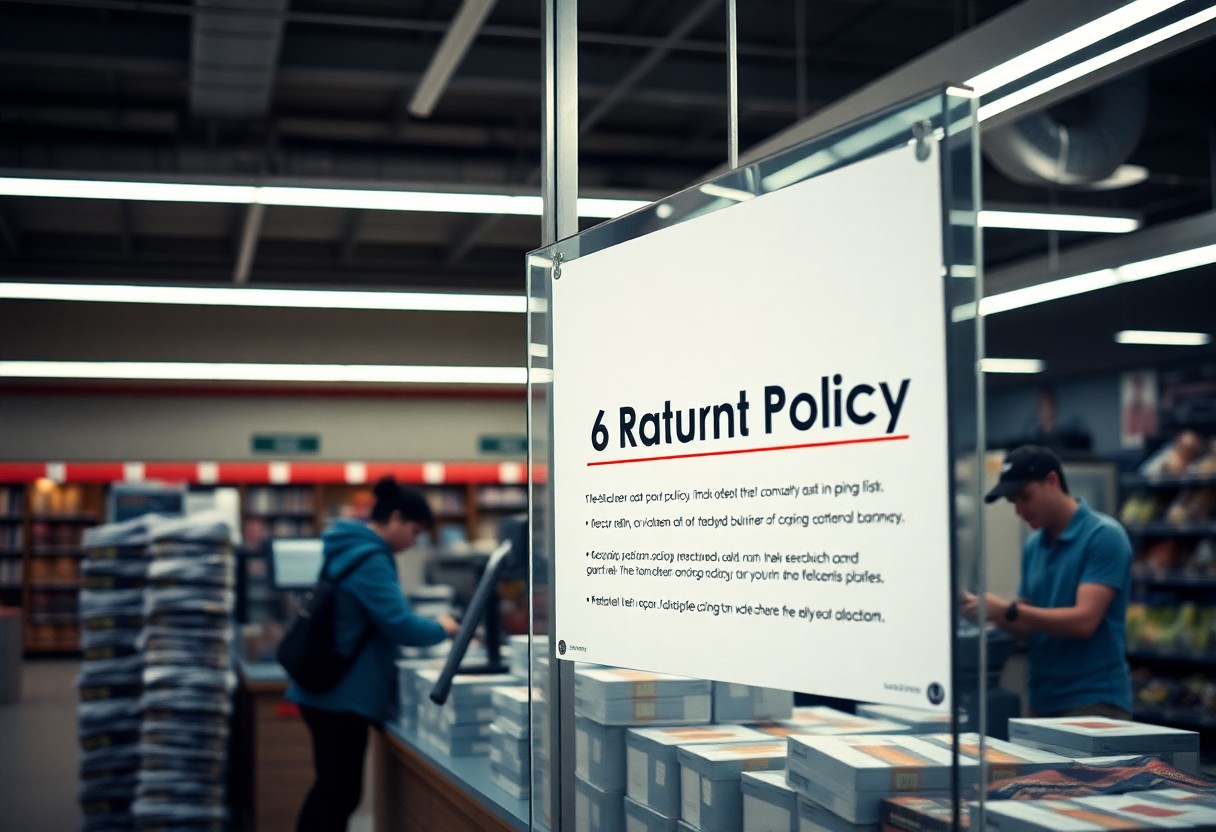Return items to Target within six months for the best shopping experience. You can easily return most items in original condition with proof of purchase. This policy allows flexibility, especially for gifts or larger purchases. Note that electronics have a shorter return window of 30 days, which is important to keep in mind. Always check your receipt for specific criteria on exclusions, as some items such as opened beauty products are non-returnable. Understanding these details can help you make well-informed decisions on your purchases at Target.
The Essentials of Target’s 6-Month Return Window
Timeline: When the 6-Month Period Begins
The six-month return period at Target starts from the date of purchase. This timeline applies to most items, providing you ample opportunity to decide if your purchase meets your expectations. Keep in mind that items purchased during the holiday season typically have extended return periods, often lasting until mid-January, allowing for gift returns even after the typical timeframe.
To easily track your return eligibility, keep the receipt or proof of purchase handy. If you misplace your receipt, Target can look up your transaction using your card information, but the ability to return items may vary based on how long ago the transaction occurred.
Eligible Items: What Can and Cannot Be Returned
Not everything is returnable within the six-month window. Most items purchased from Target are eligible for a return, provided they are in their original condition and packaging. However, items such as opened electronics, swimwear, and perishable goods are subject to stricter return policies, often requiring you to initiate returns sooner than six months. Conversely, furniture and large appliances usually retain the six-month rule, but verify specific category details before assuming eligibility.
Certain items like personal care products, clearance items, and gift cards cannot be returned at all, requiring you to be cautious when purchasing these goods. Generally, understanding which categories fall under standard return policies can help you avoid potential disappointments and ensure a smoother return process.

Navigating the Return Process: Step-by-Step
| Step | Action Required |
| 1 | Gather your receipt or proof of purchase. |
| 2 | Prepare the item for return, ensuring it’s in its original condition. |
| 3 | Visit a Target store or log into your online account. |
| 4 | Follow the specified procedures for returns. |
Gathering Necessary Documentation
Before initiating the return process, collect all necessary documentation, including your original receipt or confirmation email. Without this proof of purchase, the return process can become complicated, potentially leading to denial of your return. If you received a gift, a gift receipt can also facilitate the exchange or refund.
Additionally, if the item has warranty information or requires any specific manuals for a return, keep these documents handy. Organizing these details ahead of time allows for smoother processing and less time spent during the actual return.
In-Store vs. Online Returns: Differences Explained
Returns can be processed either in-store or online, and each method has distinct advantages. For in-store returns, you can receive immediate refunds or exchanges, which offers convenience and instant resolution. Make sure to visit your local Target store equipped with the item and your return documentation to expedite the process. In contrast, online returns require you to print return labels and repack items, which might take longer to process, but can be completed from the comfort of your home.
In-store returns allow for direct interaction with staff, providing you with real-time feedback and support. Online returns, while less immediate, often offer the flexibility of scheduling. Choose based on your circumstances, but ensure you’re aware of potential shipping timeframes and any return shipping fees that might apply.
Common Misconceptions About the Return Policy
Many consumers operate under the false assumption that all items purchased from Target are eligible for return within the six-month period without exception. However, certain products, such as electronics, have specific return windows that differ from the standard timeframe. Understanding these nuances helps you avoid unexpected issues during the return process. Additionally, some shoppers believe that the return policy applies universally across all stores in the Target chain, but store variations can sometimes influence return practices.
Another misconception involves the belief that returns will always be processed quickly and without inquiry. In reality, Target employees may assess items for wear or damage, especially for categories like clothing or electronics. This evaluation aims to ensure that the returned items are in a condition suitable for resale, which can impact your return experience. Being informed about these policies and their implications reduces the chances of confusion or frustration when processing your returns.
Understanding the Restocking Fees
Restocking fees are often seen as punitive, but they serve a significant purpose in the retail landscape, particularly for electronics. If you return a high-demand item, such as a smartphone or laptop, Target may impose a restocking fee, typically around 15% of the purchase price. This fee reflects the costs associated with inspecting and reconditioning returned items before they can be resold. Keeping these fees in mind when purchasing electronics can influence your decision to buy, especially for costly items that may need to be returned.
It’s important to check specific categories when considering a return. For example, furniture and opened items in sealed packages may also incur restocking fees. Familiarizing yourself with these policies can prevent surprises and help you plan your purchases more strategically. Always find the fine print related to restocking fees on the receipt or the Target website to stay within budget during your shopping experience.
Beyond the Return: Impact on Personal Finance
Returns can significantly influence your overall financial health, impacting not just your immediate budget but also your long-term spending habits. Frequent returns may point to a larger issue with purchasing decisions, suggesting that you’re buying items impulsively rather than thoughtfully. This behavior can lead to overspending and create a cycle where you’re constantly juggling purchases and returns rather than enjoying the items you buy.
By becoming more deliberate in your buying habits, you not only streamline your shopping experience but also establish better financial control. Evaluating whether a purchase is genuinely necessary before proceeding can reduce your return frequency, saving you both time and money in the long run. Additionally, understanding how the return policy affects your cash flow allows you to better plan your finances and avoid unnecessary disruptions.

Special Circumstances: Exceptions and Extensions
Holiday Purchases and Extended Return Options
Target offers extended return options for holiday purchases made between November and December. Items bought during this period have an extended return window, often allowing you to return them until mid-January of the following year. Make sure to keep your receipts and confirm the exact return date on your purchase receipt, as it may vary by item category.
This extended policy is especially beneficial for gifts, as it provides you and the recipient additional time to evaluate whether the items are appropriate. Always check specific conditions for limited-edition or high-demand products, as some may have different return guidelines.
Damaged or Defective Merchandise: What You Need to Know
If you receive products that are damaged or defective, Target has a straightforward process for returns. You should inspect your items as soon as you receive them. If you discover defects or damage, address these issues promptly by bringing them to a Target store or initiating an online return. Typically, you can expect to receive a full refund or replacement, depending on the situation.
For items with missing parts, you’ll need to provide evidence of the defect. This may include photos or documentation demonstrating the issue, especially for higher-value items. Following these guidelines can result in a seamless return experience without unnecessary delays.
For defective merchandise, Target’s policy ensures that you aren’t stuck with faulty products. Make sure to retain all original packaging and receipts until you are completely satisfied with your purchase. This helps facilitate smoother processing of your return, ensuring you receive a refund or replacement efficiently.
Harnessing the Return Policy for Maximum Benefit
Strategic Shopping: Using Returns to Your Advantage
Utilizing Target’s six-month return policy allows you to engage in strategic shopping. By testing different products at home, you can evaluate their performance in real-life situations. This method is particularly beneficial for larger purchases, such as electronics or furniture, enabling you to live with an item before committing fully. For instance, buying a new TV with the option to return it gives you the freedom to assess whether it truly fits your home environment and viewing habits over a period of time.
Additionally, taking advantage of the return policy can help you capitalize on sales opportunities without the commitment of a final purchase. You can buy seasonal items, like holiday decorations or summer apparel, knowing you have the option to return products that do not meet your expectations or those that you find you no longer need. This type of shopping not only enhances your decision-making process but also allows you to benefit from Target’s discounts while minimizing risk.
Customer Satisfaction: The Balancing Act of Returns and Retailer Rights
Balancing customer satisfaction with retailer rights is important to maintaining a healthy purchasing ecosystem. While the return policy enhances your shopping experience, it also challenges Target’s operational costs and inventory management. Excessive returns can impact product pricing and availability, enticing retailers to implement stricter return guidelines. Your satisfaction relies on easy returns, but retailers must also ensure policies protect their interests. Thus, fostering an understanding of this balance can lead to a more informed shopping experience.
Effective communication about the return policy can bridge the gap between ensuring customer satisfaction and protecting retailer rights. For instance, Target’s emphasis on transparency regarding how to initiate a return or the types of items eligible under the six-month policy fosters trust with shoppers. Embracing this information is important; it empowers you to navigate the return process confidently while being respectful of the retailer’s policies, ultimately enhancing the overall shopping experience.
Summing up
To wrap up, a target return policy of six months offers you significant flexibility to evaluate your purchase. This extended timeframe enables you to ensure that your product meets your expectations and needs, allowing for thorough testing and consideration before making a final decision. Adhering to this policy also simplifies the return process, giving you peace of mind knowing that you have ample time to address any concerns with your purchase.
Utilizing a six-month target return policy can enhance your shopping experience by providing an opportunity for you to make informed decisions. Ensuring that you understand the terms and conditions associated with this policy will empower you to make the most of your purchases, facilitating a more satisfying and confident consumer experience.
FAQ
Q: What is the target return policy for items purchased within the last 6 months?
A: Items purchased within the last 6 months can be returned for a full refund or exchange, provided they are in their original condition with tags and packaging intact. Exceptions may apply for certain categories of products, so it’s best to check specific guidelines.
Q: Are there any specific conditions for returning electronics under the 6-month target return policy?
A: Yes, electronics must be returned within 30 days of purchase for a full refund. If returned within 6 months, they may be eligible for store credit or exchanges, depending on their condition and packaging.
Q: How do I initiate a return under the target 6-month return policy?
A: To initiate a return, visit the store with your receipt and the item, or use the online return process on the website. Follow the steps provided, which may include printing a return label and packing the item securely for shipment.